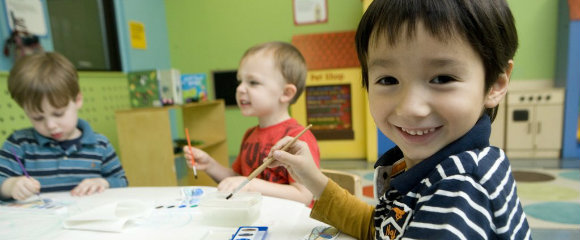
Ten Timely Tips for Transitioning From Relaxed Summer Days to the First-time School Experience
By Leslie Bushara, Deputy Director, Children’s Museum of Manhattan
1. Understanding Your Child: You are the best advocate for your child and the most sensitive to their needs. Let your child’s temperament guide you in planning the summer-to-school transition. Some children embrace the excitement. Others will be cautious, and may be apprehensive as they venture out for the first time without parents or caregivers.
2. Sharing Books: Enjoy books together that build confidence and social skills. Reading pictures books about going to school, saying goodbye and talking about new feelings can help your child understand what to expect in a non-threatening way. Some favorites books include:
- Billy and the Big New School by Catherine Antholt
- Oh My Baby, Little One by Kathi Applet
- I Like Me! by Nancy Carlson
- I Am Absolutely Too Small for School by Lauren Child
- Chrysanthemum by Kevin Henkes
- Miss Bindergarten Gets Ready for Kindergarten by Joseph Slate
- The Dot by Peter Reynolds
- Wow! School! by Robert Neubecker
- Leo the Late Bloomer by Robert Krauss
- First Day of School by Anne Rockwell
- It’s Time for Preschool by Esme Raji Codell
We also suggest, to help prepare children ages birth to five for learning and language, that you visit CMOM’s All the Way to K and Beyond! web page. It’s full of free, fun reading tips, videos, art projects and family activity posters. (En español)
3. Rest: It is tempting to stay on a relaxed summer schedule as long as possible, but it isn’t helpful for first-time school-goers. Build in time for your child to adjust to an earlier bedtime. Set them up for success by gradually sending them to bed earlier each night and, depending on their school’s schedule, waking them earlier each morning.
4. Routines: Many children crave familiarity. Take first-time students to their nursery school or kindergarten several times before school starts. Follow the same route each time. Have fun finding landmarks to point out and share on each trip.
5. School Traditions: Celebrate this important step! As your budget allows, let your child pick out something new and special to be used when they go to school. It can be a lunch box, a special outfit or even a new box of crayons. Some families have an annual First Day of School breakfast or a special food treat for the first day’s lunch or dinner.
6. Lunch Date: Practice packing your child’s lunch box together and have “school lunch” together.
7. Saying “Goodbye”: Establish a goodbye routine. A special handshake, hug or saying that is just between you and your child can help assuage fears and remind your child that you are there to support him or her.
8. Make your child comfortable: Find out about bathroom procedures at the school. Explain them to your child in advance and, if appropriate, pretend-play at home to help make sure your child is comfortable with what needs to be done.
9. Share stories: Share tales about when you went to school and what you did. Find photos of yourself and your friends.
10. Special Art Projects: Make a book at home about the new preschool experience using pictures of your child. Take photos of the front of the school and your child on the first day, etc.
11. Parental Anxiety: Keep in mind that your child may not be the only one who’s excited and nervous about this big step. Be conscious of your demeanor as this new adventure begins. If possible share concerns out of earshot young children.
 Leslie Bushara is Deputy Director of the Children’s Museum of Manhattan, an expert in parent engagement and early childhood learning, and a mom. At the Museum, she oversees educational and outreach initiatives including the Museum Early Childhood Program. During her 23 years at the Museum, Leslie developed the successful EatPlayGrow™ health curriculum for children, families and educators in partnership with the National Institutes of Health, and the Museum’s new All the Way to K and Beyond! literacy resources for families in partnership with the NYC Department of Education and Johns Hopkins Science of Learning . She also spearheaded and oversees the Museum’s University Research Partnerships which explore relationships between children, families and learning.
Leslie Bushara is Deputy Director of the Children’s Museum of Manhattan, an expert in parent engagement and early childhood learning, and a mom. At the Museum, she oversees educational and outreach initiatives including the Museum Early Childhood Program. During her 23 years at the Museum, Leslie developed the successful EatPlayGrow™ health curriculum for children, families and educators in partnership with the National Institutes of Health, and the Museum’s new All the Way to K and Beyond! literacy resources for families in partnership with the NYC Department of Education and Johns Hopkins Science of Learning . She also spearheaded and oversees the Museum’s University Research Partnerships which explore relationships between children, families and learning.
With more than 350,000 visitors annually, the Children’s Museum (www.cmom.org) is New York City’s premiere institution committed to the well-being of children. The Museum creates hands-on learning environments, programs, and curricula built on evidence-based early childhood research and the magic of museum sciences. In addition to its commitment to delight and educate visitors, the Museum offers resources and strategies for parents, caregivers and educators to help children become lifelong learners. Thousands more New Yorkers benefit from the Museum’s offerings through its outreach programs at schools, Head Start centers, shelters, libraries and hospitals. www.cmom.org




